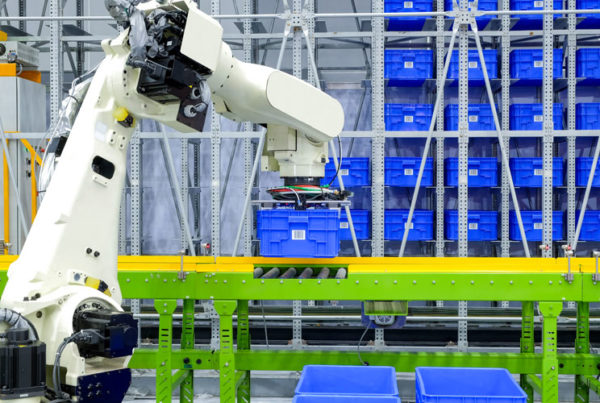Before the coronavirus pandemic, online shopping was rising steadily. Adjusting fulfillment strategies to match that pace was a challenging but obtainable goal. The year-over-year growth between 2018 and 2019 of 14.9% was respectable. However, it did not prepare companies, or their supply chains, to meet the 93% growth seen in May of 2020.
While the shift toward eCommerce has been dramatic enough to stagger supply chains, sales haven’t been evenly distributed across the industry. Essentials – especially toiletries, groceries, and medicine – moved more quickly than they could be supplied. Luxury goods, however – high-end clothing, electronics, luggage, and briefcases – have been left to sit in warehouses.
These variables have merged in a manner, and at a time, that has left the available warehousing space insufficient to meet demand. The ratio of inventory-to-sales had been declining for decades as global supply chains moved more and more toward just-in-time logistics. But the pandemic disrupted these supply chains. The closing of borders, ports, and factories to prevent the spread of COVID meant stores and warehouses were emptied of essential items with delays in replenishment.
As factories and borders opened back up, retailers looked to stock more of these essential goods closer to their customers. They needed to protect themselves from further demand shocks – but found themselves in the veritable warehousing desert created by just-in-time logistics. Not only was space limited but, too often, it was filled with the luxury items that hadn’t moved since early 2020.
Meanwhile, at the other end of their business, their consumers were making purchases still with the pre-COVID expectation that they might be delivered in as little as a day.
To meet these changing needs, retailers have to adjust the way they understand warehousing. Before 2020, warehousing was seen strictly as a cost, and the goal was to eliminate that cost as much as possible by delivering goods just-in-time. Today, warehousing is understood to be more than a necessary insurance against demand shock. It’s also a means of bringing the product closer to the end-user to satisfy their expectation of speedy delivery, especially for the essential goods they’re unable to buy in brick-and-mortar stores.
Distributing more inventory closer to consumers is being made possible by space-saving advances in warehousing designs, a changed perspective on what buildings even constitute a warehouse and the continued adoption of intelligent automation.
This three-part series will look at some of the issues with the current state of available warehousing space, how that lack of space challenges eCommerce companies in particular, how changes in the urban landscape will be part of the warehousing solution, and what role intelligent automation will play in the next generation supply chain model.
The lagging indicator: Speculative warehouse development
The coronavirus pandemic drove people away from brick-and-mortar stores and to eCommerce at unprecedented, and unexpected, rates. Many experts predict that the shopping habits created in 2020 won’t return to pre-pandemic norms. There’s good evidence to support this belief; even when stores were re-opened after lockdowns, studies show that people continued their online shopping habits.
According to Digital Commerce 360, eCommerce in the US in 2019 totaled $598 billion. But, while the numbers are still being tabulated for 2020, it’s expected to have jumped to $839 billion and to reach $1.5 trillion by 2025, according to Jones Lang LaSalle Incorporated (JLL).
As businesses adjust to this increase in online shopping, many retailers insist their vendors increase the amount of inventory they keep available. Experts predict that we’ll need 5-10% more inventory across markets to endure the kinds of demand shocks seen in 2020. At the same time, major brick-and-mortar stores such as Walmart, Home Depot, and Best Buy are turning parts of their stores into eCommerce hubs and mini-distribution centers.
Creating a more resilient and flexible supply chain, one that’s capable of withstanding demand shocks like the pandemic of 2020 and also of providing next-day or even same-day delivery, takes space. And warehouses across the country have been filling up – the national vacancy rate hit a near-record low of 4.7% in the late summer of 2020, with less than 23 million available square feet.
At the same time, the speculative development of real estate has lagged behind the changing needs. Still working under the old paradigm of just-in-time logistics, only 6 million square feet is currently under construction.
While some markets will fare better than others, on a national scale, this amount of construction isn’t expected to offset the demand for space that the new supply chain models will require.
New locations need to be found – and made operational – quickly.
To do that, the fulfillment industry will have to look at some old real estate in a new way. And they’ll have to look to the latest technologies in robotics and automation in order to meet consumer expectations and to keep up with their competition.
We discuss that and more in our next article.
Optimized space utilization and improved productivity for growing television retailer
Streamlined IT processes provided enhanced customer visibility into incoming orders and fulfillment while offering flexible growth strategy. The integration allowed for optimized space utilization of the facility, and ergonomic picking with use of goods-to-person stations and pick-by-light functionality drove productivity.






